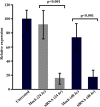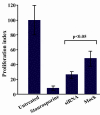The effect of sortilin silencing on ovarian carcinoma cells
- PMID: 25215181
- PMCID: PMC4147104
The effect of sortilin silencing on ovarian carcinoma cells
Abstract
Background: Our preliminary data on the protein expression of SORT1 in ovarian carcinoma tissues showed that sortilin was overexpressed in ovarian carcinoma patients and cell lines, while non-malignant ovaries expressed comparably lower amount of this protein. In spite of diverse ligands and also different putative functions of sortilin (NTR3), the function of overexpressed sortilin in ovarian carcinoma cells is an intriguing subject of inquiry. The aim of this study was, therefore, to investigate the functional role of sortilin in survival of ovarian carcinoma cell line.
Methods: Expression of sortilin was knocked down using RNAi technology in the ovarian carcinoma cell line, Caov-4. Silencing of SORT1 expression was assessed using real-time qPCR and Western blot analyses. Apoptosis induction was evaluated using flow cytometry by considering annexin-V FITC binding. [(3)H]-thymidine incorporation assay was also used to evaluate cell proliferation capacity.
Results: Real-time qPCR and Western blot analyses showed that expression of sortilin was reduced by nearly 70-80% in the siRNA transfected cells. Knocking down of sortilin expression resulted in increased apoptosis (27.5±0.48%) in siRNA-treated ovarian carcinoma cell line. Sortilin silencing led to significant inhibition of proliferation (40.1%) in siRNA-transfected Caov-4 cells as compared to mock control-transfected counterpart (p < 0.05).
Conclusion: As it was suspected from overexpression of sortilin in ovarian tumor cells, a cell survival role for sortilin can be deduced from these results. In conclusion, the potency of apoptosis induction via silencing of sortilin expression in tumor cells may introduce sortilin as a potential candidate for developing a novel targeted therapy in patients with ovarian carcinoma.
Keywords: Apoptosis; Cancer; Ovary; Silencing; Sortilin; siRNA.
Figures





Similar articles
-
Production and Characterization of a Novel Monoclonal Antibody Against Human Sortilin.Monoclon Antib Immunodiagn Immunother. 2015 Dec;34(6):390-5. doi: 10.1089/mab.2015.0042. Monoclon Antib Immunodiagn Immunother. 2015. PMID: 26683178 Free PMC article.
-
Ectopic Expression of Sortilin 1 (NTR-3) in Patients with Ovarian Carcinoma.Avicenna J Med Biotechnol. 2009 Jul;1(2):125-31. Avicenna J Med Biotechnol. 2009. PMID: 23407681 Free PMC article.
-
Diagnostic and Therapeutic Implications of Sortilin Expressed on the Surface of Bladder Carcinoma Cells.Iran J Pathol. 2022 Spring;17(2):174-182. doi: 10.30699/IJP.2022.539411.2732. Epub 2022 Mar 8. Iran J Pathol. 2022. PMID: 35463727 Free PMC article.
-
[Impact of biological function on ovarian clear cell carcinoma ES2 cell line with ARID1A gene expression down-regulating in vitro].Zhonghua Fu Chan Ke Za Zhi. 2016 Mar;51(3):209-15. doi: 10.3760/cma.j.issn.0529-567X.2016.03.009. Zhonghua Fu Chan Ke Za Zhi. 2016. PMID: 27030501 Chinese.
-
The Peptide-Drug Conjugate TH1902: A New Sortilin Receptor-Mediated Cancer Therapeutic against Ovarian and Endometrial Cancers.Cancers (Basel). 2022 Apr 8;14(8):1877. doi: 10.3390/cancers14081877. Cancers (Basel). 2022. PMID: 35454785 Free PMC article.
Cited by
-
Significance of Endocan Expression in Various Types of Epithelial Ovarian Tumors.Iran J Pathol. 2022 Spring;17(2):202-209. doi: 10.30699/IJP.2022.540192.2740. Epub 2022 Mar 8. Iran J Pathol. 2022. PMID: 35463733 Free PMC article.
-
Production and Characterization of a Novel Monoclonal Antibody Against Human Sortilin.Monoclon Antib Immunodiagn Immunother. 2015 Dec;34(6):390-5. doi: 10.1089/mab.2015.0042. Monoclon Antib Immunodiagn Immunother. 2015. PMID: 26683178 Free PMC article.
-
Tumor co-expression of progranulin and sortilin as a prognostic biomarker in breast cancer.BMC Cancer. 2021 Feb 22;21(1):185. doi: 10.1186/s12885-021-07854-0. BMC Cancer. 2021. PMID: 33618683 Free PMC article.
-
Establishment and validation of a novel immune-related prognostic signature in malignant pleural mesothelioma.Ann Transl Med. 2022 Feb;10(4):200. doi: 10.21037/atm-22-527. Ann Transl Med. 2022. PMID: 35280360 Free PMC article.
-
Overexpression of sortilin is associated with 5-FU resistance and poor prognosis in colorectal cancer.J Cell Mol Med. 2021 Jan;25(1):47-60. doi: 10.1111/jcmm.15752. Epub 2020 Dec 16. J Cell Mol Med. 2021. PMID: 33325631 Free PMC article.
References
-
- Tinger A, Waldron T, Peluso N, Katin MJ, Dosoretz DE, Blitzer PH, et al. Effective palliative rad-iation therapy in advanced and recurrent ovarian carcinoma. Int J Radiat Oncol Biol Phys. 2001;51(5):1256–1263. - PubMed
-
- Velasco AP, Herraez AC, Ruiperez AC, Rincon DG, Garcia EG, Martin AG, et al. Treatment guide-lines in ovarian cancer. Clin Transl Oncol. 2007;9(5):308–316. - PubMed
-
- Oei AL, Sweep FC, Thomas CM, Boerman OC, Massuger LF. The use of monoclonal antibodies for the treatment of epithelial ovarian cancer (review) Int J Oncol. 2008;32(6):1145–1157. - PubMed
-
- Vincent JP, Mazella J, Kitabgi P. Neurotensin and neurotensin receptors. Trends Pharmacol Sci. 1999;20(7):302–309. - PubMed
LinkOut - more resources
Full Text Sources
Other Literature Sources
Research Materials
